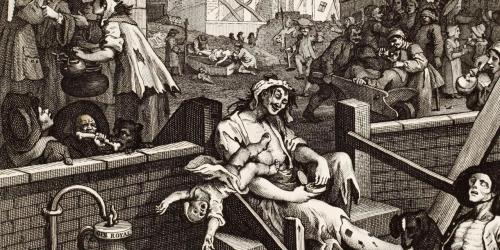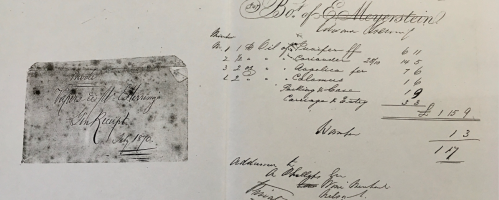‘Civilization’, said the American novelist, William Faulkner, ‘is distillation’. His own contribution to distillation was the brewing of bathtub gin during Prohibition – raw spirit smuggled in from Cuba cut with juniper essence but we will pass rapidly on from that.

William Faulkner, novelist and gin maker
Although the term gin first came into use in the early eighteenth century in Britain, it had a long antecedent history in the ‘geneva’ (named after juniper rather than the Swiss city) of the Low Countries. As Bernard Mandeville eloquently put it in 1714, gin was:
the infamous Liquor, the name of which derived from juniper berries in Dutch, is now by frequent use and the Laconick spirit of the nation, from a word of middling length shrunk into a Monosyllable.
To reinforce its infamy, Mandeville added a concise but far from cheerful description:
Intoxicating Gin, that charms the unactive, the desperate, and crazy of either Sex […] It is a fiery Lake that sets the Brain in flame, burns up the Entrails, and scorches every Part within; and at the same time a Lethe of Oblivion, in which the Wretch immers’d drowns his most pinching Cares.’
In other words, it was probably pretty similar to Faulkner’s bathtub gin – and to the drink of the ‘Gin Craze’ of eighteenth-century London (as depicted by Hogarth), which was cut with turpentine, vitriol and other noxious substances.

Hogarth’s ‘Gin Lane’ – courtesy of bbc.com
In the unprohibited British market, gin started to improve towards the end of the 1830s with Aeneas Coffey’s refinement of the continuous still. This produced a clearer, purer spirit with far fewer impurities. The only problem was that, as William Loftus’s 1850 Mixing and Reducing Book for the Use of Publicans makes abundantly clear, the spirit that came out of the still underwent a fair amount of, shall we say, ‘further work’ in the interests of both customers’ tastes and publicans’ profits.
Though Loftus claimed that ‘purity and wholesomeness have come to be regarded as of high importance’ he also noted that ‘coarse and injurious stuff is still consumed in many quarters’. His survey of 24 London pubs suggested that the alcohol content ranged from 14 to 61 ‘under proof’. Full proof gin we now know as 100% proof. That was the Navy standard, so that if you spilled gin on the gunpowder it would still explode. The sugar content in the gins sampled by Loftus ranged from entirely unsweetened to a sugar content of over 13 ozs per gallon. Those with low alcohol content had, he suggested, almost certainly been cut with the addition of Cayenne pepper to mimic the burn of higher alcohol.
Cayenne pepper was not one of Loftus’ recommended flavourings (though ‘chilies’ were). His taste ran to the classic botanicals, but he also pointed to the considerable differences between the ‘palates’ of the different gins. The difference, he said, ‘between Liverpool and Bristol gin, or between that prepared at Bristol and at Plymouth is as remarkable as the difference between Dublin and London stout, or Scotch and Irish malt whiskey’.
It’s noticeable that Bristol – in both these comparisons – is the odd one out. What was Bristol gin and how did it differ from standard gin?
We now have an answer. And it’s not just a report from an old text but a real drink. Michael Palij MW has turned from wine to gin and recreated Bristol gin from ingredients lists and a recipe found in the Bristol archives. In most gins the botanicals (flavourings such as juniper, orris root, angelica, orange peel and so on) are macerated or distilled together with the consequence that the flavours blend together. In Bristol gin they are not only distilled separately but distilled only when each is in season, giving fresher and more distinctive flavours. The botanicals – including Tuscan juniper and hand-cut Valencia oranges – that go into Smeaton’s Bristol Method Dry Gin are individually distilled in traditional copper pot stills.

Smeaton’s Bristol Method Dry Gin

Smeaton’s – the recipe and the botanicals
Dry Gin, by the way, was the taste of the upper classes. The poorer the district the more sugar in the recipe. In the Victorian view of the world to appreciate dry champagne you had to start early and drink often. Was the same true of gin? Well yes, according to Loftus. Only the ‘respectable and monied classes’ preferred dry gin. Perhaps they too started young and drank often.
